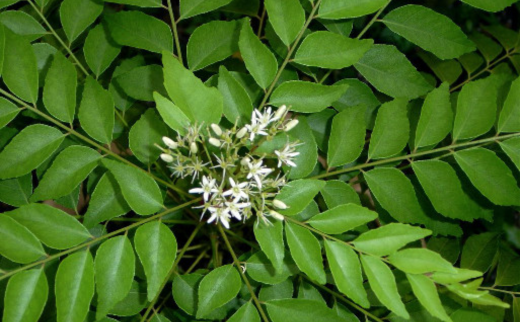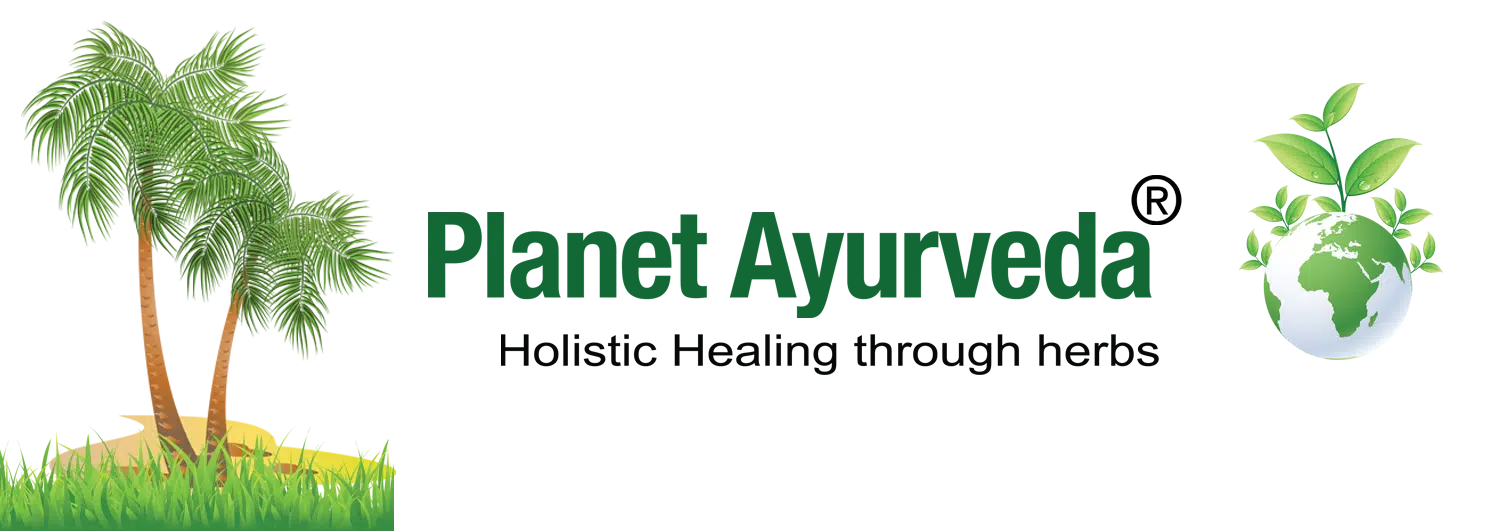Murraya koenigii L. Sprengel/Kaidarya/Curry Leaves/Kadi Patta – Ayurvedic Uses & Benefits
Abstract
Kaidarya (Murraya koenigii L. Sprengel), an important herb of Indian origin, has been used traditionally and for medicinal purposes since ancient times. It is known for various synonyms such as Surabhinimba in Sanskrit, Curry Leaf in English, Mitha Neem in Hindi, and Karuveppilai in Tamil. The plant mainly grows in Tropical and sub-tropical regions of the Indian subcontinent. The present study aims to review classification, morphology, properties, and therapeutic uses of the plant.

Introduction
The plant belongs to the Rutaceae family, which comprises nearly 150 genera and 1600 species. It is mainly cultivated in Sri Lanka, Australia, Southeast Asia, Tamil Nadu, Maharashtra, and North India. Kaidarya (Murraya koenigii L. Sprengel) is mentioned as Kari in Tamil and Kannada literature. Curry leaf, a term now frequently referring to Murraya koenigii L. Sprengel, is derived from the Tamil word Kari, which means ‘Spiced sauce’. It is used as a flavouring agent and is considered an important ingredient in Indian spices. The plant is considered a tonic and stomachic and has several traditional uses. It can be used fresh, dry, powdered, or in cooked form.
- Botanical source – Murraya koenigii L. Sprengel
- Family – Rutaceae
Scientific Classification
- Kingdom – Plantae
- Subkingdom – Tracheobionata
- Super division – Spermatophyta
- Division – Magnoliophyta
- Class – Magnoliopsida
- Subclass – Rosidae
- Order – Sapindales
- Family – Rutaceae
- Genus – Murraya
- Species – Koenigii
Synonyms
- Chardighna: Leaves are used to treat chardi (emesis).
- Girinimba: A type of Neem (Azadirachta indica) growing on mountains.
- Kaidarya: As it possesses various therapeutic actions.
- Kaphaghna: Leaves are used to pacify kapha dosha.
- Raamann: Another variety of Neem (Azadirachta indica).
- Mahanimba: Its leaves have a similar appearance to those of Neem (Azadirachta indica).
- Maharishtra: Useful in the cure of many Roga (diseases).
Vernacular Name
- English: Curry Leaves
- Kannada: Karibevu
- Hindi: Kadipatta
- Punjabi: Gandla, Gandalu, Bowala
- Gujrat: Goranimb, Khadilimbdo
- Tamil: Kariveppilai
- Malayalam: Kariveppu
- Marathi: Kadhilimb
- Sanskrit: Girinimba, Surabhinimba
- Telugu: Karepeku
- Uriya: Basango, Marisingipotoro, Bhursunga, Sanomorisingi
Habitat
The plant grows all over India from the Himalayas to Assam, Sikkim, the Western Ghats, and Kerala. Murraya koenigii L. Sprengel is a tropical and subtropical small tree or shrub that grows up to a height of 6 -15 feet. Its seeds are used for propagation and germinate in dense or light shade areas.
Morphology
Kaidarya (Murraya koenigii L. Sprengel) is an aromatic shrub that grows up to a height of 2.5 meters. It has a main stem of about 16 cm in diameter covered with bark. A white wood under the bark is visible when it is peeled off longitudinally. The leaves are 30 cm long, bipinnately compound with reticulate venation, comprising 24 lance-shaped leaflets (4.9 cm long, 1.8 cm wide), and have a 0.5 cm long petiole. The flowers are bisexual, complete, funnel-shaped, white, scented, actinomorphic, androceium polyandrous with ten stamens, gynoecium 5-6 mm long with a superior ovary. The plant possesses a terminal cyme inflorescence bearing 60-90 flowers. Fruits are oblong or spherical (1.4-1.6 cm long, 1-1.2 cm wide). Fruits become black when fully mature.
Classical Categorization
- Charak Samhita: Samjnasthapana Mahakashaya
- Shaligrama Nighantu: Guduchyadi Varga
- Madanpala Nighantu: Shaaka Varga
- Raj Nighantu: Prabhadradi Varga
- Nighantu Adarsh: Beejapurakaadi Varga
Rasa Panchaka (Ayurvedic Properties)
- Rasa (Taste): Katu (Pungent), Tikta (Bitter), Kashaya (Astringent)
- Guna (Qualities): Laghu (Light), Sheeta (Cold)
- Veerya (Potency): Sheeta (Cold)
- Vipaka (Post digestive effect): Katu (Pungent)
- Prabhava (Special action): Deepana (Stimulate digestive fire), Pachana (Digestion)
- Doshakarma (Effect on Dosha): Vatakaphahara (Pacify Vata and Kapha Dosha)
Therapeutic Indications
- Ruchya (Improve taste)
- Deepana (Stimulate digestive fire)
- Pachana (Improves digestion)
- Vishagna (Antitoxic)
- Santapa (Fever)
- Shosh (Atrophy)
- Kustha (Skin disorder)
- Krimi (Worm)
- Atisara (Diarrhoea)
- Agnimandhya (Weak digestive fire)
- Sadyovrana (Wound)
- Prameha (Diabetes)
Chemical Constituents
1. Major
Essential oil (0.14-0.32% v/w) containing sabinene (31.8-44.8 %), betacaryophyllene (24.4%), alphapinene (19-19.7%) and betaphellandrene in major quantity.
2. Minor
Alpha-terpinene, betaocimine, linalool, terpinen 4 ol, betapinene, are minor composition of essential oil present in plant. Some alkaloids such as koenimbine, koenigicine, mahanimbine, mahanimbicine, koenidine, girinimbine, mahanine, curryangine, murrayanine, cyclomahanimbine, curryanine, mukonine, isomahanimbine, mukonicine are present in leaves of Kaidarya (Murraya koenigii L. Sprengel). Its leaves also contain nicotinic acid, carbohydrates, proteins, fibre, carotene, and minerals.
Pharmacological Activity
- Anti-inflammatory
- Antimicrobial
- Antihelminthic
- Antidiabetic
- Anticancer
- Antioxidant
- Hepatoprotective
Therapeutic Uses As Per Ayurvedic Text
- The plant Kaidarya (Murraya koenigii L. Sprengel) is mentioned in Samjnasthapana Mahakashaya in Charaka Samhita
- It is one of the ingredients of Vachadya ghrita used in Apasmara (Epilepsy) as Dhupana (Fumigation) and Pradeha (Ointment)
- Juice of Curry leaves along with Ela (Elettaria cardamom) and Madhu (honey) are used in Kaphaja Mutra Kricchra (Difficulty in passing urine)
- The use of Kaidarya (Murraya koenigii L. Sprengel) as Murdha virechana (Nasya- therapy to eliminate doshas from the head region) is mentioned in Apachi (Non-cancerous lump) chikitsa
- For children up to age 1 year, Kaidarya (Murraya koenigii L. Sprengel) is mentioned in the drugs used for Sisuprasa (Therapy to increase immunity)
- To enhance intelligence, wisdom, and strength of body in children, Kaidarya is given with Shwetadurva (Cynodon dactylon), Hema churna (Gold powder), Ghrita (Ghee) and Madhu (Honey)
Ethnomedicinal Uses
- To stop vomiting or dysentery, leaves are chewed in raw form
- The leaves are used to cure cough, hepatitis, hypertension, and rheumatism
- In Punjab, paste of leaves is applied externally to cure bruises
- In Assam, the juice from its root is used for pain associated with the kidneys
- Its fruits are Astringent and are used in Diarrhoea and Dysentery in some regions
- The decoction of its leaves is used internally in snake bites, and the paste of the root is applied to the bitten part in some regions
- Paste of leaves mixed in buttermilk is useful in stomach upsets and acts as laxative when taken on an empty stomach
- Traditionally, leaves are boiled together with coconut oil and applied to hair for natural growth
Recent Research Works
- Essential oils such as alphapinene, sabinene has shown antibacterial effects against Bacillus subtilis and Corynebacterium pyogenes
- Antidiabetic, antibacterial, anticancer, and antioxidant properties are present in the plant due to its carbazole alkaloids
- Mahanimbine has been observed to decrease the blood sugar level in Swiss mice
- The aqueous extract from its leaves stimulate and speed up the process of wound healing
- Ether extract from Murraya koenigii has been observed in decreasing the cancer cells in mice
- The folic acid, beta carotene, calcium, riboflavin, and zinc present in the leaves of Murraya koenigii are used for oral health and for the production of mouthwash
Useful Parts
Leaves, roots
Dosage
- Churna – 3-6 gm
- Juice – 10-20 ml
Classical Ayurvedic Formulations
- Samjnasthapana Mahakashaya
- Vachadya ghrita
- Shanabijadi Churna
Conclusion
Kaidarya (Murraya koenigii L. Sprengel), is a very potent medicinal herb used globally in all traditional systems of medicines. The plant possess Katu (Pungent), Tikta (Bitter), Kashaya (Astringent) rasa (taste), Sheeta (Cold) veerya (potency), and Katu (pungent) vipaka (post-digestive effect), by which it helps in curing several digestive issues like agnimandhya (Weakened digestive fire), atisara (Diarrhoea) etc. This plant possesses anti-inflammatory, antihelminthic, antimicrobial, antidiabetic, and antioxidant properties, which are helpful in the management of several diseases.
FAQs
1. What are the health benefits of Kaidarya
- Supports digestion and reduces nausea/ vomiting
- Helps manage blood sugar levels
- Promotes hair growth and reduces hairfall
- Protects liver health and detoxifies the body
2. Can Kaidarya be consumed daily
Yes, it can be safely included in the daily diet. However, concentrated supplements or extracts should be taken as per dosage instructions.
3. Are there any side effects
Kaidarya is generally safe. Rarely, excessive consumption in supplement form may cause digestive discomfort. Pregnant or breastfeeding women should consult a doctor before taking concentrated forms.
4. Is Kaidarya beneficial for diabetes
Yes, it may help regulate blood sugar levels by improving insulin function and reducing oxidative stress.
5. Can Kaidarya improve hair health
Yes, their antioxidant and vitamin-rich composition can strengthen hair follicles, reduce hair fall, and prevent premature graying.
6. Can I take it in supplement form
Yes, its supplements (capsules or extracts) are available. It is recommended to follow the manufacturer’s dosage instructions.



